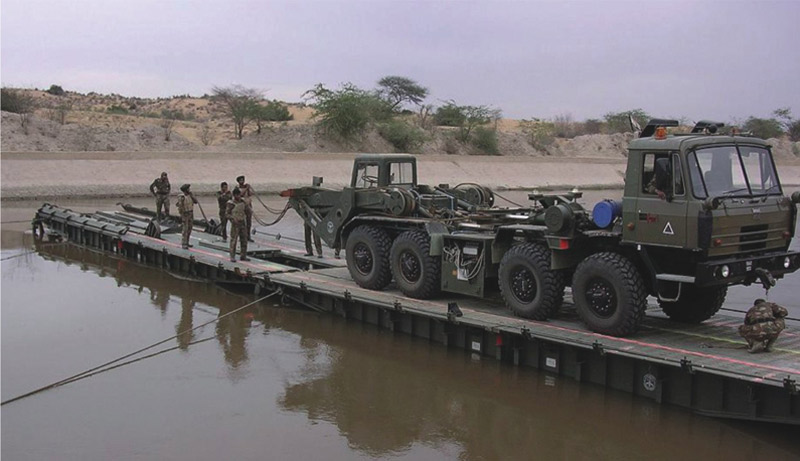The Corps of Engineers with their motto of SARVATRA (Ubique in Latin, or ‘Everywhere’ in common parlance) are a league apart.
The officers of the Corps of Engineers are armed with a degree in engineering.
The ‘Sappers’ (as the Engineers are commonly known) are adept at a wide variety of important operational tasks ranging from minefield laying and clearing, bridging, road construction, handling of explosives etc.
“Mobility and counter-mobility can be termed as some of the important aspects of warfare in which the Engineers play a major role”
The Corps of Engineers of the Indian Army is one of the oldest arms of the Indian Army. It was established in the year 1780 when the two regular pioneer companies of the Madras Sappers were raised.
Subsequently, the Group of Madras, Bengal and Bombay Sappers were formed and later merged on 18 November 1932 to form the Corps of Engineers in its present form. They were formed into field companies (a sub-unit organisation that exists to this day) grouped into regiments.
The Corps of Engineers of the Indian Army consists of three major constituents namely Combat Engineers, MES (Military Engineering Service) and Border Roads. The Corps also provides officers to the Military Survey and Defence Research & Development Organisation (DRDO).
The military engineer is arguably the most under-rated individual on the battlefield. Yet military engineers have been leaders in innovation in the face of the enemy for centuries.
Any number of specialist corps originated within the engineers and at least one life-saving trade as well — firefighters. The artillery, the signals corps, among others, owe their existence to the intrepidity of the engineers — those who built and operated the “engines” or siege machines.
The South African Engineer Corps (SAEC) earned much kudos during World War Two — so much so that King George VI afterwards awarded another two flames to their “bursting grenade” corps insignia, raising the number to nine. It was — and remains — a singular honour.
What do Engineers do? Role of The Corps of Engineers
The fundamental task of the engineers can be summarised in a single word: mobility.
It is their mission to enhance (or at least maintain) own forces mobility while doing all they can to hinder enemy movement.
They do this by providing routes and bridging for personnel and vehicles to reach their objectives and by denying the enemy the same through demolitions, the wrecking of roads, culverts, defiles, bridges and the emplacement of mines.
They are also expected to develop existing routes and provide others to allow for supply of troops in combat positions.
This task flows into the host of household chores that make up the engineers’ secondary function. These include:
- Acting as lead agency for camouflaging and concealing field positions and installations. In this regard they also assist the commander’s deception plan.
- Construction: Engineers are responsible for planning, designing, constructing and supervising the erection of any number of structures for field forces and rear-area troops. These range from digging and fortifying defensive positions and helping other arms entrench to building landing zones, airstrips and air bases, to constructing and maintaining barracks, workshops, storage facilities and offices. The latter includes looking after the electrics and plumbing.
- Demolitions: Arguably the “fun” part, engineers are often called to blow things up. Objects range from enemy field fortifications to unwanted installations and dumps, captured equipment or unserviceable machinery.
- Minelaying: Engineers are often called to plan, construct or supervise the emplacement of mines and landmines. The latter refers to anti-personnel (AP) and anti-tank mines. The former are large quantities of explosives secreted within or under a structure and detonated by remote control or time-delay. During World War Two Russian engineers have numerous successes with radio-controlled mines and on one celebrated occasions killed a German divisional commander and his staff near Kiev when a mine obliterated the building they were occupying.
- Mine clearing: Equally often, engineers are called on to remove own or enemy mine fields or to sweep routes for mines.
- Reconnaissance: There are always engineer parties in the forward areas seeking technical information such as the condition of roads and bridges, the whereabouts of enemy minefields and river crossings as well as the availability of local building materials.
- Water Provision: Clean water and proper sanitation is the difference between a dying and a fighting army. Historically more soldiers have died from diseases (including water-borne cholera) than from combat. Finding and then providing clean drinking water is a thankless, but vital, engineering task.
- The Engineers also have a number of ancillary tasks. These include:
-
Auxiliary Infantry: Engineer sub-units are generally assigned to infantry or armour units and normally carry out the bulk of their tasks in the forward areas, often under enemy fire. As a result it has long been the norm to train them as infantry.
- Surveying and Map-making: Accurate maps are an essential precondition for successful military operations.




